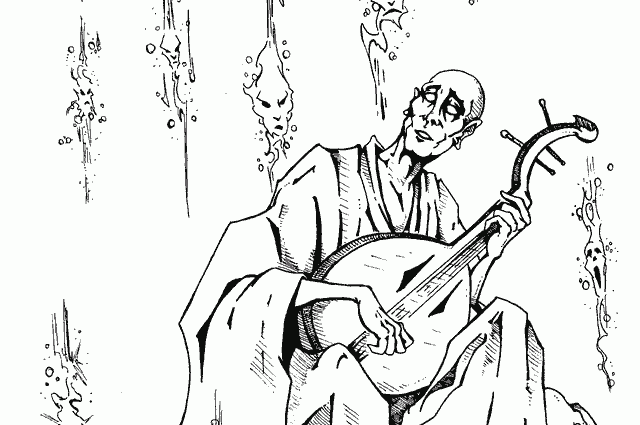Japan has a long and legendary history, filled with ancient, mysterious, and often dark folklore. We’ve looked through old spells, witchcraft, and unknown elements of dark Japanese magic, and in this list will touch on some lesser known legends that are circulating about Japan. Many people are familiar with much of Japan’s mystical history, but these are the tales that don’t get nearly the attention they probably should.
This list was written by Antony Cummins, who has done extensive research into Japan’s dark history while writing his book The Dark Side of Japan. Check out Antony’s book in our link at the end of this list.
10. The Magic of the Animal Kingdom

Dark folklore surrounds the animal kingdom, and in Japan things can get strange. Foxes have hidden wisdom and deep power, they can act as protection from dark powers or can bring calamity and mischief to an intended victim. When a magical fox reaches 1,000 years old, it can turn silver white and grow nine tails. Likewise, dogs hold power and can possess entire families, making them outcasts in society. There are many stories about how both foxes and dogs outwit humans.
Or how about the evil badger who killed and chopped up a man’s wife? After the badger had killed her, it magically took on the image of the wife and then served him her human flesh to eat. The humble mosquito is thought to be the soul of a human who was evil in life and is cursed to spend its very short life sucking blood from others. Finally the cat, who was kept on board ships because it was thought that the white crests of the waves were the hands of drowned sailors trying to climb back on to a ship. However, the cry of the cat kept the dead sailors in the depths and allowed the ship to have safe passage.
9. The Japanese Medusa

It is said that the real intentions of a lady can be shown by her reflection and shadow. A gentleman who wishes to know the mindset of a woman should watch her reflection in a mirror, and if the beauty he observes in the reflection is actually a hag with writhing snakes for hair, her heart is impure, and a relationship with her would be catastrophic.
Likewise, if two women appear to get on in polite conversation then check their shadows: if both shadows display angry snakes in the hair, each trying to bite at each other, then know that the women actually hate each other, in truth, even though their conversation is polite.
8. Japanese Curse Dolls

We all know the now famous movie trope of the ‘voodoo’ doll, but accounts in Japan show us of a type of straw doll used for cursing a person. To make one, create a small straw figure, then write the name and age of the target on paper and insert it into the doll. Next, draw a face on a separate sheet of paper and fix it to the figure.
At night, visit a sacred space and find an old tree, then with an iron crown on your head (which holds three candles), wait for the hour of the Ox – this is similar to our own ‘witching hour’ but the time is actually between 1:00 and 3:00 a.m. At this time, nail the doll to the old tree and your curse will manifest itself on your victim.
7. Ku Magic

One of the vilest and deadliest forms of magic to be found in China and Japan is Ku magic. A black wizard will collect as many venomous animals as they possibly can: snakes, insects that bite, and any creature that carries poison. They place them all in a closed pot and leave them to starve. The last creature alive in the pot becomes a ku-creature, an animal of extreme and deadly power.
The evil magician keeps his ku-creature and whenever they wish to kill someone they can bring its enormous power to bear. The creature is run over food that is to be eaten, and when the victim eats this food they will die in fits of coughing and blood. It is even said that whatever food the victim has eaten will become whole and return to life in their stomach, bursting the victim from the inside. Furthermore, the souls of the victims are then locked and bound to the magician and they will serve the ku-wizard in the next life.
6. The Demon’s Gate

Direction and time feature prominently in Japanese folklore and legend. It is said in Japanese tradition that certain directions are the realm of demons and of influential spirits. To counter the effects of these otherworldly entities, the Japanese would protect important sites in various ways, and they would concentrate their protection from that direction.
One example was to have an inward facing corner, so that spirits from that direction would become confused and disorientated by the strange architectural feature. Another way was to construct holy sites at certain points away from the place that is to be protected. You may not know this, but even today, Edo Castle – which is now the palace of the Japanese Emperor – is spiritually protected by shrines and temples around modern day Tokyo, sacred places that have been there for generations and which maintain the spiritual barrier, protecting the royal family for those directions. These protection sites are not close by and it takes a train ride to get to them, but their function of keeping demons at bay still goes on to this day.
5. The Magic of Incense

We can all picture beautiful temples in dark green forests in Japan, their dimly lit alters clouded by incense smoke. This smoke has various rituals and properties attached to it. Incense smoke is used near the dead to cleanse the air and deter any malign entities from coming close to the body so that the soul has a clear pathway to the afterlife, and so that the body is not corrupted by evil.
Incense can also be used to call on the ghosts of the dead. A stick is lit and the magic user calls out for the dead to appear before them, such as a family member or dead lover. The apparition of the ghost will appear in the smoke but will say that it does not have long and that the connection to this world is short and that it must return to the afterlife, even so a brief conversation can be had with a departed loved one. However, the problem with incense sticks is that when lit they do attract ‘incense eating goblins’ who hang around bodies and temples trying to get a free feed.
4. The River to Hell

The Japanese have their own version of our River Styx – the river to hell, or sometimes the river to the underworld or afterlife. The Japanese version is known as ‘the river of three roads’ and leads souls on to where they should go. Those who have been bad in life are led to the afterlife by a blind guide, and along the banks of the river, a ginormous old hag steals the clothes of the dead or makes dead children cry.
The souls are protected by a Saint Jizo, who helps the children find their way and brings them peace. Saint Jizo is a popular image in Japan and you have probably seen statues of him many times. The Japanese king of hell is helped by ministers who hold up mirrors so that people’s true natures are reflected. This delivers the truth of the way they led their lives so that they can be assessed.
3. The Crying Stone

The wife of a soldier was lost without her loving husband, who was away at war, so she went on the road trying to find her love. Along the road she was attacked and raped, an assault which resulted in a baby boy. She died in child birth, and the boy was raised by a holy man. When the child came of age, he tracked down the brute who took his mother and killed him, exacting his revenge.
Legend says that at the spot where the rape took place there is a stone that cries out. It is said that on nights of wind and rain the stone can be heard crying and wailing into the night, the soul of the woman lamenting for her love and for her misfortune.
2. The Blind Storyteller

There was once a blind storyteller who traveled and played his lute to crowds, singing of old deeds and long dead samurai. One night he was telling the tale of an ancient and famous battle to a crowd of eager listeners. Night after night he came back to the same spot to continue the epic story. However, novice monks brought the old man into a monastery after they had heard him play and they told him that he had in fact been playing for the ghosts of the very same warriors of the story, and that they were reliving their long ago battle.
In utter fright, the storyteller asked for help, and as night fell the crowd of hungry dead listeners grew louder outside the monastery walls. The monks covered the storyteller in holy script, drawing all over him from head to foot, all except for his ears. The storyteller was advised to ignore the ghosts as the magical script would hide him. When he left the the holy ground, the next night the ghosts were baying for him to finish the story but all they could see was a floating lute and a pair of ears, so they tore the ears off of his head in anger and returned to their graves. The novice monks had not quite saved all of him from the angry audience because they forgot to write the magical spells on every part of his body.
1. Lovers Reunited

After all that darkness and evil we would like to end on a story of love. There was once a young samurai and his wife, who were soulmates and truly in love. But the wife became ill and it soon became clear that she was to die. She told her warrior-husband that he should wait for her, and that she would be reborn and find him again. Then, she died in his arms. Years passed and as a samurai it was his duty to form an alliance with another family and he was forced into marriage. After many years his second wife and his son both died and again he was alone.
One day while he was traveling, he came to an inn and was served by a younger woman who had come of age. She was so like his first wife that he asked her questions to find out if it was truly her. When she responded to the enquiries she took on the ghostly voice of his first wife, and told him about their promise and about her coming back to find her true love again. At this she fell to the floor unconscious and never again remembered the incident. The two were married and true love found happiness again.
Get a copy of Antony’s book The Dark Side of Japan here.